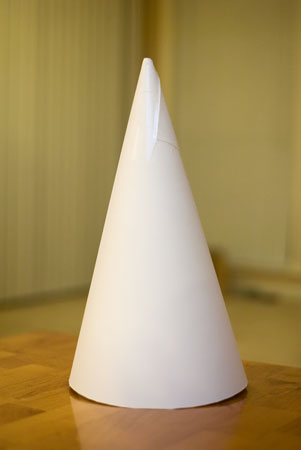Archive for August 26, 2009
Insulated 12 Gauge Wire Antenna
Alright, so time to build the next antenna.
The first antenna was made out of bare 8 gauge wire, but wasn’t very carefully designed, nor did it have very many turns in the coil. I don’t know how many are necessary, but I do want something that looks a little closer to this.
I had about 33 feet of insulated 12 gauge copper wire, the largest gauge insulated wire that Home Depot carried, so I pulled it out to make my next antenna.
With the paper template at the ready, I cut the length of wire in half and coiled the two cables around the template simultaneously so that each one would be very similar, with the same number of coils, a similar spacing between each loop, and so on.
Coil the wire was pretty easy at the top where everything was still close together, because I could hold it in place with my hand. The lower down we got, the larger the loops, and the more likely it would be that things would start getting messy, that the first wire would cross over the second wire, that the spacing between each loop would vary, and so on.
Anyways, once the two individual coils were built, I took them off the template, separated them, and got to the process of trying to intertwine them.
The first thing that I found was that the coil was very springy and had a tendency to elongate when taken off the template. When this happens, the important 33 degree angle of the apex shrinks.
The connectors I got from Home Depot must be the wrong ones because they flat out hold. I grabbed some duct tape and taped the bare ends of the wires together, leaving a little bit of wire exposed so that I’d have something to spark when it came time to activate this antenna with an AC circuit.

Duct Tape Connection
Here is the completed antenna, laying on its side:

Insulated 12 Gauge Wire Antenna
There’s a few things to point out:
- It looks a little better constructed than my previous antenna.
- There are way more rotations in each cone, 17 to be exact.
- The antenna bows down when laid horizontal like this.
- The spacing between the larger loops are significantly larger than the spacing between the smaller loops.
- The cones overall are less than 33 degrees since the antenna is stretched out.
Because the coil was stretched out, I decided to use gravity as my friend and have it stand vertically so that it’d compress back down to its proper shape. This works, but the base loop was is too weak to support the entire structure and it just falls right on over.
So I need a stand, a thin vertical bar to hold the antenna in place.

Insulated 12 Gauge Antenna on a Stand
Okay sweet, so now it’s vertical but still not quite symmetrical. Here’s a closer view so you can see what I mean:

Insulated 12 Gauge Wire Antenna: Vertical
You can see it still has a tendency to fall over to one side. So to use this antenna, not only would I need a vertical support system, but I’d also need something to keep the innards from flopping over to one side.
hmmm. My intuition says that it does need to be symmetrical and precisely designed so that it resonates at a particular frequency. I’m gonna need something a little more, hmm, professional? than this.
Building a Template
So one of the main problems with my first antenna was that it looked like crap. 😀 I coiled the cable by hand in the air and it didn’t turn out so well. This time I wanted to create a hard cone-shaped shell to wrap a cable around.
With a large 33 degree angle spanning several sheets of paper laying on the table, I got a large piece of posterboard and curled it up into a cone and taped it down when it was the right angle. (Having a partner here helps to tape down the edges while you hold the posterboard in place.)
Trim down the bottom so that it has a relatively flat base and you’re good to go. It wound up being about 20″ tall or so.

Paper Antenna Template
Now, I’m gonna want to make sure it maintains its shape when I start applying pressure onto it by squeezing it with copper wire. A pair of balls will work fine, a tennis ball to support the apex and a larger bouncy ball to support the larger section. They’re both lightweight and resistant enough to push back when I apply pressure.

Paper Antenna Template with Guts
With the balls shoved inside the paper template, we’re good to go!